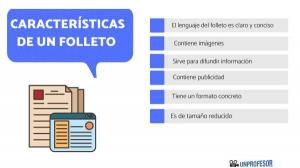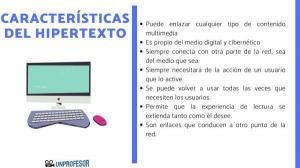CONNOTATIVE and DENOTATIVE language
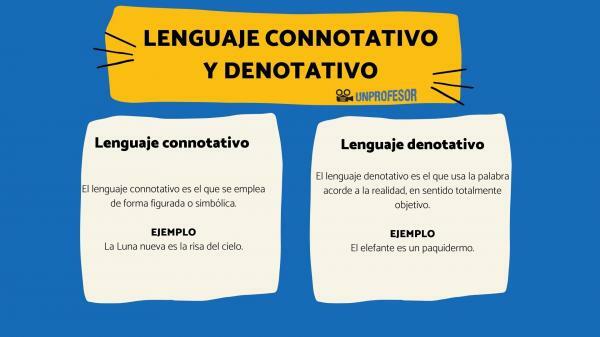
Spanish is a very rich language full of details to know that is worth studying. Fortunately, we enjoy a language that allows us great communicative advantages and it is something that we must value. However, it is up to us to take care of it and empower it, therefore, in this lesson from a PROFESSOR that concerns us here, we are going to know what is connotative and denotative language.
In addition, so that everyone is perfectly clear what it consists of, also we will add examples, so that we will know perfectly well when the words are being used in a habitual, literal, real, imaginary sense or in reference to something else. From here, take a pencil and paper, because the lesson begins.
Index
- What is connotative language
- Characteristics of connotative language
- What is denotative language
- Characteristics of denotative language
- Difference between denotative and connotative
- Denotative and connotative meaning: exercises with solutions
- Solutions of the denotative and connotative language exercises
What is connotative language.
In the first place, to know what connotative and denotative language is, we are going to comment on defining the first one, so we can establish the differences between the two.
Connotative language is that which is used figuratively or symbolically. In this way, it not only communicates information, but also provides feelings and sensations.
This type of language is widely used in different environments, such as everyday and colloquial use, but it is also found quite a bit in literary texts. It is because it refers to the suggestive and ambiguous possibilities of language, so that its aesthetics are defined and with style, capable of expressing emotions subjectively, which leads it to allow different readings or interpretations.
In short, the connotative lexicon allows the use of a word in a figurative sense, supported by circumstantial facts that depend on the context, and can be used as a comparison, poetry, etc.
Examples of connotative language
Let's see some examples of connotative language:
- A bird in the hand is worth two in the bush.
- The new moon is the laughter of heaven.
- The coldness of not observing to hide.
Image: Tes
Characteristics of connotative language.
Connotative language refers to the ability to to connote, that is, to suggest. Therefore, it is a type of language that is subjective and that is found above all in the literary text but, also, is part of colloquial speech. The connotative lexicon is used to define reality as it is, however, the connotative indicates a reality that has passed through the filter of subjectivity and, therefore, does not reflect reality in a flat and direct.
Here we leave you some features of the connotative language that deserves to take into account:
- Depends on the context: in order to better understand the message that you want to convey to us, it is essential that we assess the context in which is the phrase or word, only then, we can understand what is its meaning and the intention of the issuer / author
- Emotional function of language: it is a type of language that is included in this linguistic function that aims to convey a feeling or emotion
- Unofficial use: Due to the fact that it is a type of objective language, it will never be part of official, technical or scientific texts since it is an appreciation of reality that is shown here.
- Personal character: the use that is given to the connotative language is totally linked to the person who makes use of said language and is that it is a particular and individual use of the language
- Abundant in the literature: in the literary resources It is where we most find the influence of connotative language

Image: Lifeder
What is denotative language.
Denotative language is the one who uses the word according to reality, on totally objective sense. That is, when a form of expression is used to say something as it is, it is said that it has been done using this type of language, objectively, communicating with total clarity, in the spirit of being perfectly understandable without the need for the receiver or listener to make any kind of interpretation, and without the use of symbologies.
So it can be said that this type of language is used as a reference to a fact or data, directly, that is, denotes and names it. That is why it is not so common to find it in literary texts.
In the case of denotation, the meaning is more important than the signifier, so the emphasis is on who emits the information, that you must be clear about the ideas you are going to convey, launching messages with the exact words that describe the information, without creative use any.
It is a language used to inform and transmit information, so that it can only be read in one way and it does not admit various or free interpretations, although it could have some complementation with respect to the connotation, but it is not usual.
Examples of denotative language
In this case, denotative language examples They are:
- I have read this page of the newspaper.
- The elephant is a pachyderm.
- Today I go to school to go to math class.
- The cleaner cleans the whole house.
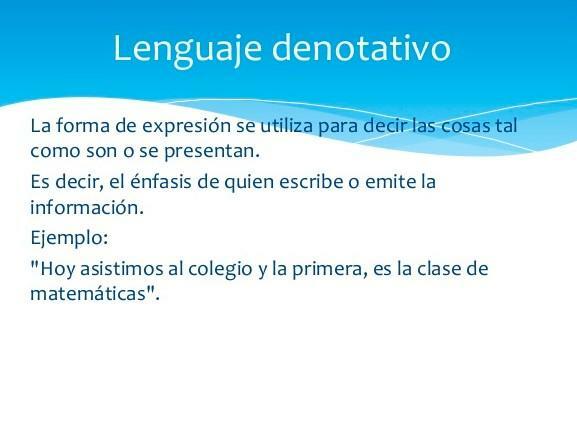
Characteristics of denotative language.
Now we will know the characteristics of denotative language to better understand what this type of language is like. The first thing we have to bear in mind is that the objective pursued with this language is to communicate, informTherefore, the most subjective judgments are set aside to reflect reality or a fact directly.
Denoting means naming and that is precisely what denotative language does, which simply names, enumerates, the facts in an objective way and without personal influences or personal judgments. Here is a list of the most outstanding features:
- Information transmission: The main objective of denotative language is to communicate information, therefore, it is done from a non-literary or emotional point of view.
- Importance of meaning: it does not matter so much how the message is said but what matters is the content of the message itself, the meaning
- Target language: Unlike the connotative, in the denotative subjective judgments are set aside to offer an objective and clear communication
Image source: Slideshare
Difference between denotative and connotative.
Having said all this, we can establish a series of differences between connotation and denotation:
- While denotation seeks to offer objective information far from interpretations, the connotation try to create feelings and emotions in the receiver using the words in a not literal, but rather interpretive way.
- On the one hand, the denotation can only be interpreted in literal meaning, while the connotation It allows various interpretations depending on both the receiver and the sender.
- Context is very important in connotation, as it influences the interpretation of the phrase. This does not happen in denotation, as it is only factual information.
- The language connotative It is widely used in literary texts, especially poetic or lyrical, while the denotative it's more journalistic, also used in studies, essays, newspaper articles, etc.
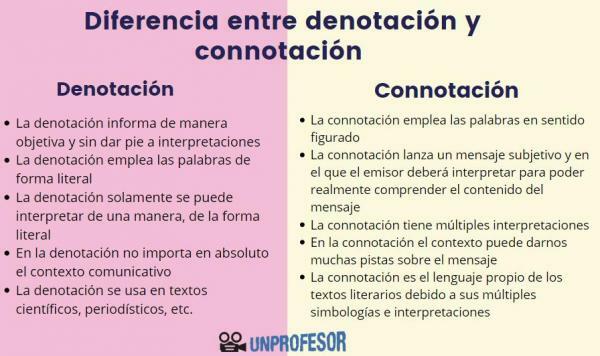
Denotative and connotative meaning: exercises with solutions.
We will end this lesson on connotative and denotative language with a series of exercises with solutions So that, thus, you can put into practice your knowledge on this subject. Here we leave you the exercises and in the next section you will be able to check your results with the solutions and see if you have done well.
Exercise: Indicates the denotative and connotative meaning of the following words:
- Bird.
- Moon.
- Blood.
Solutions of the denotative and connotative language exercises.
Here we leave you the solutions from the previous exercise so that you can check if you have finished understanding the lesson well:
Bird
- Denotative. Bird with wings and feathers that has the ability to fly.
- Connotative. A bird can have many connotative meanings, but one of the most common is that it is a symbol of freedom.
Moon
- Denotative. The moon is the satellite of the Earth and has four defined phases whose cycle is completed in 28 days.
- Connotative. The moon can mean romanticism, love, eroticism, and so on.
Blood
- Denotative. Blood is a tissue that connects the body and carries nutrients and oxygen to cells.
- Connotative. Blood can refer to passion, pain, emotions ...
If you want to read more articles similar to What is connotative and denotative language - With examples, we recommend that you enter our category of Writing.
Bibliography
- Jofré, M. (2017). Function of denotation and connotation in discourse. Chile: University of Chile. Retrieved on, 11 (04), 2018.
- Genette, G. (1970). Poetic language, poetics of language. New Vision Editions.
- Jofré, M. (2000). Critical Semiotics of Denotation and Connotation. Cyber Humanitatis.

